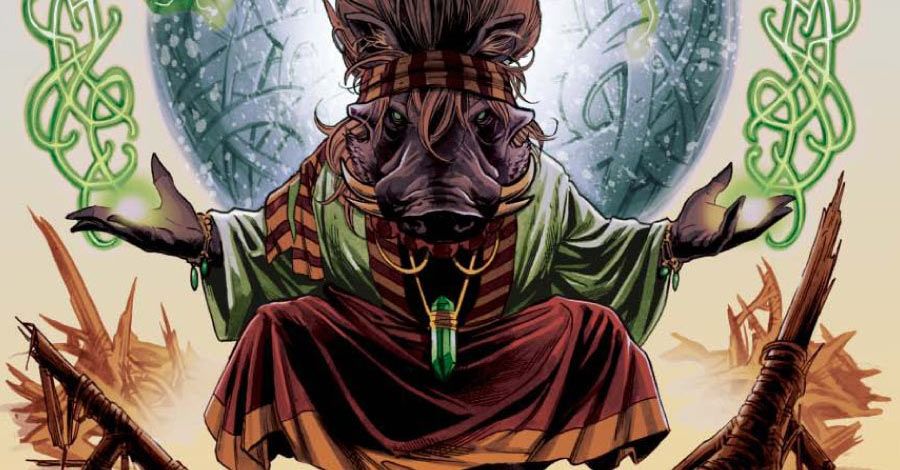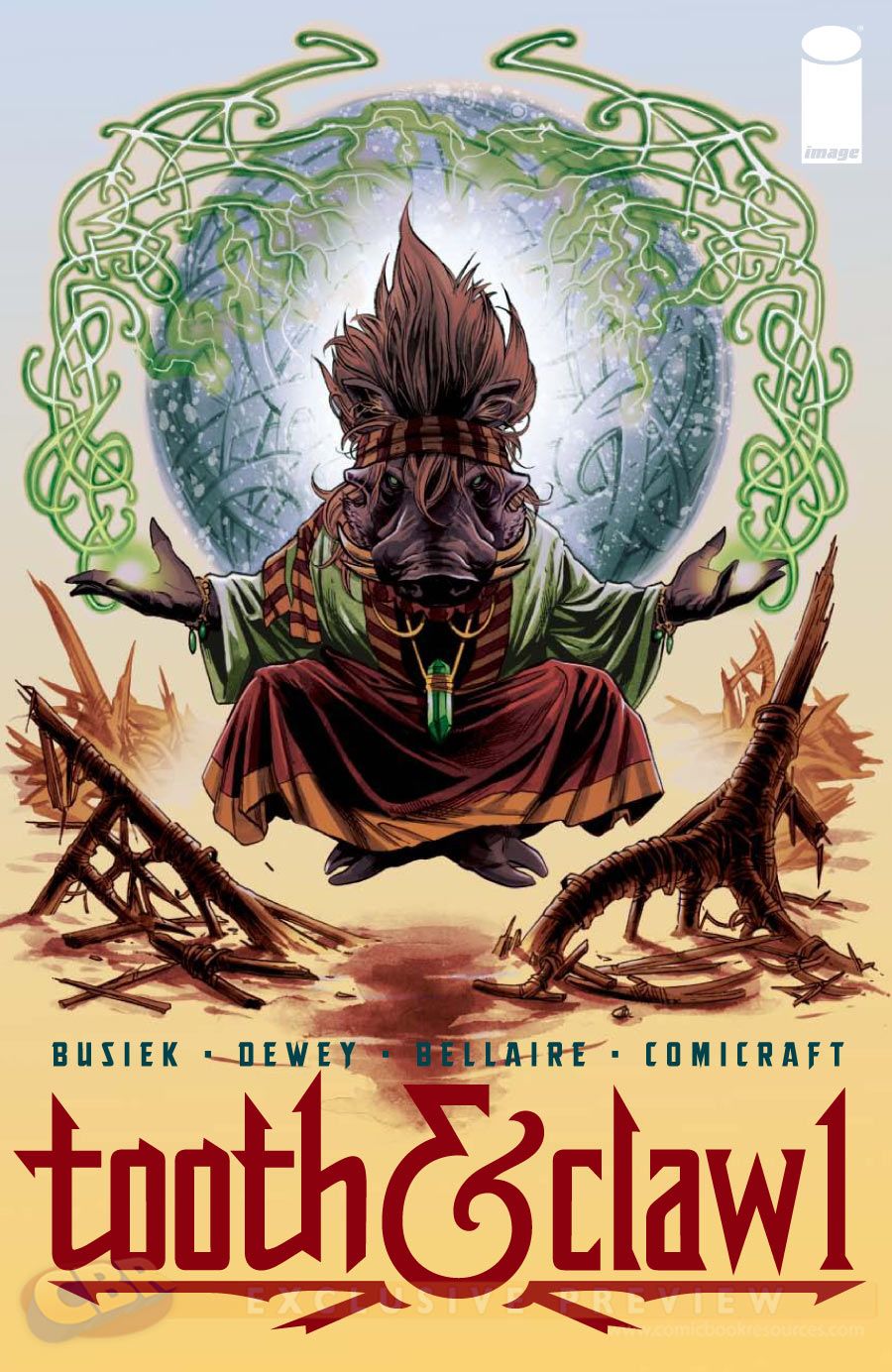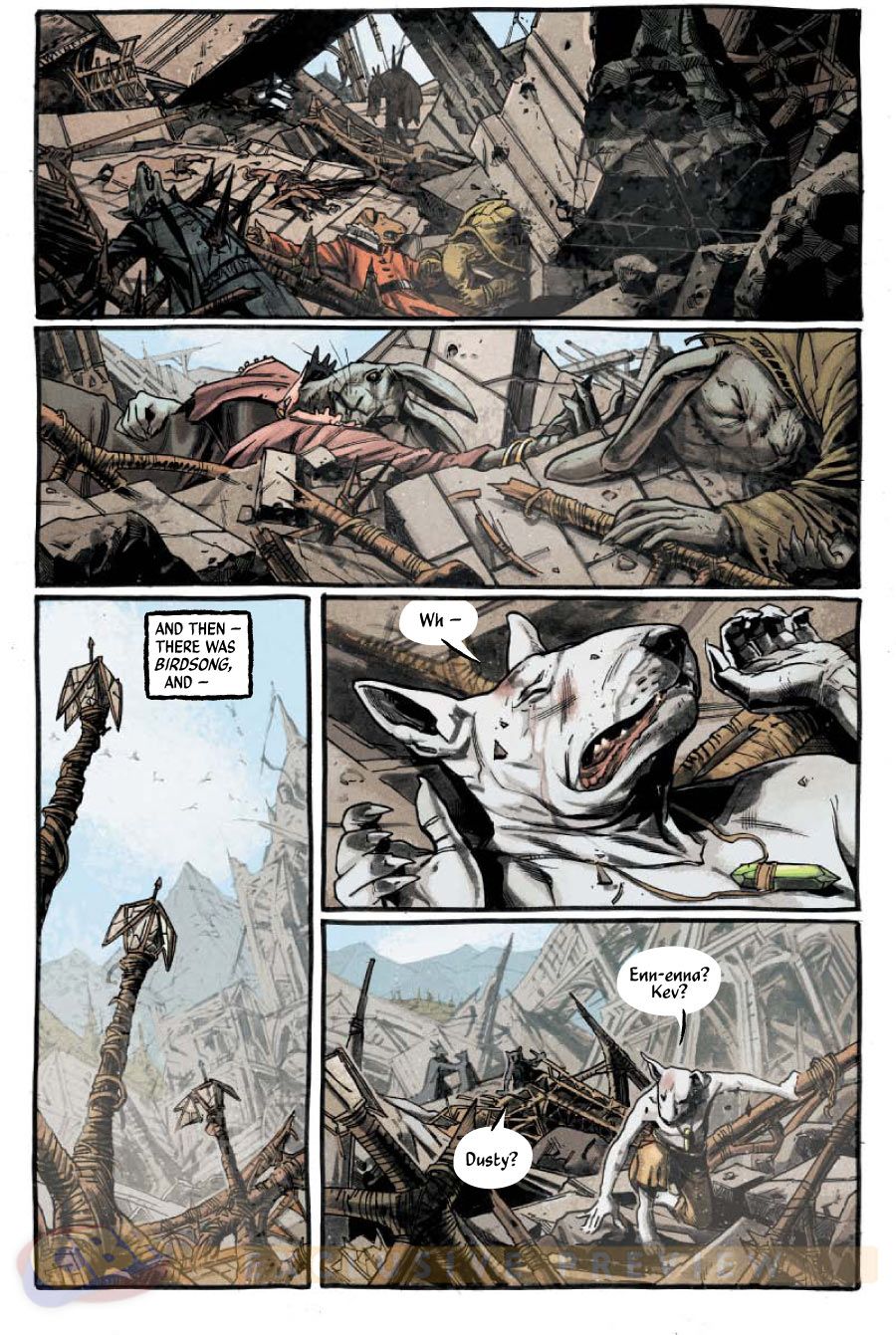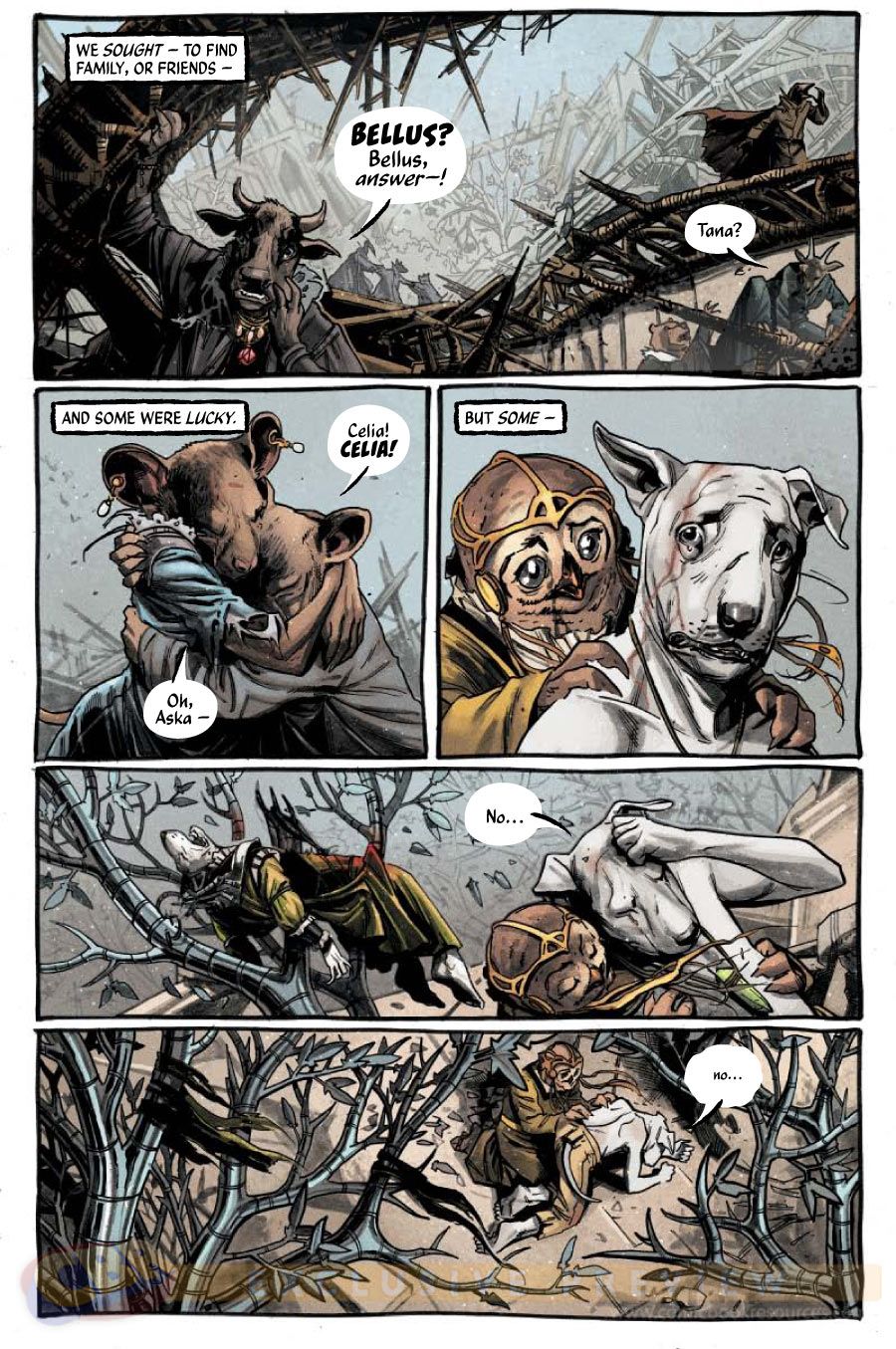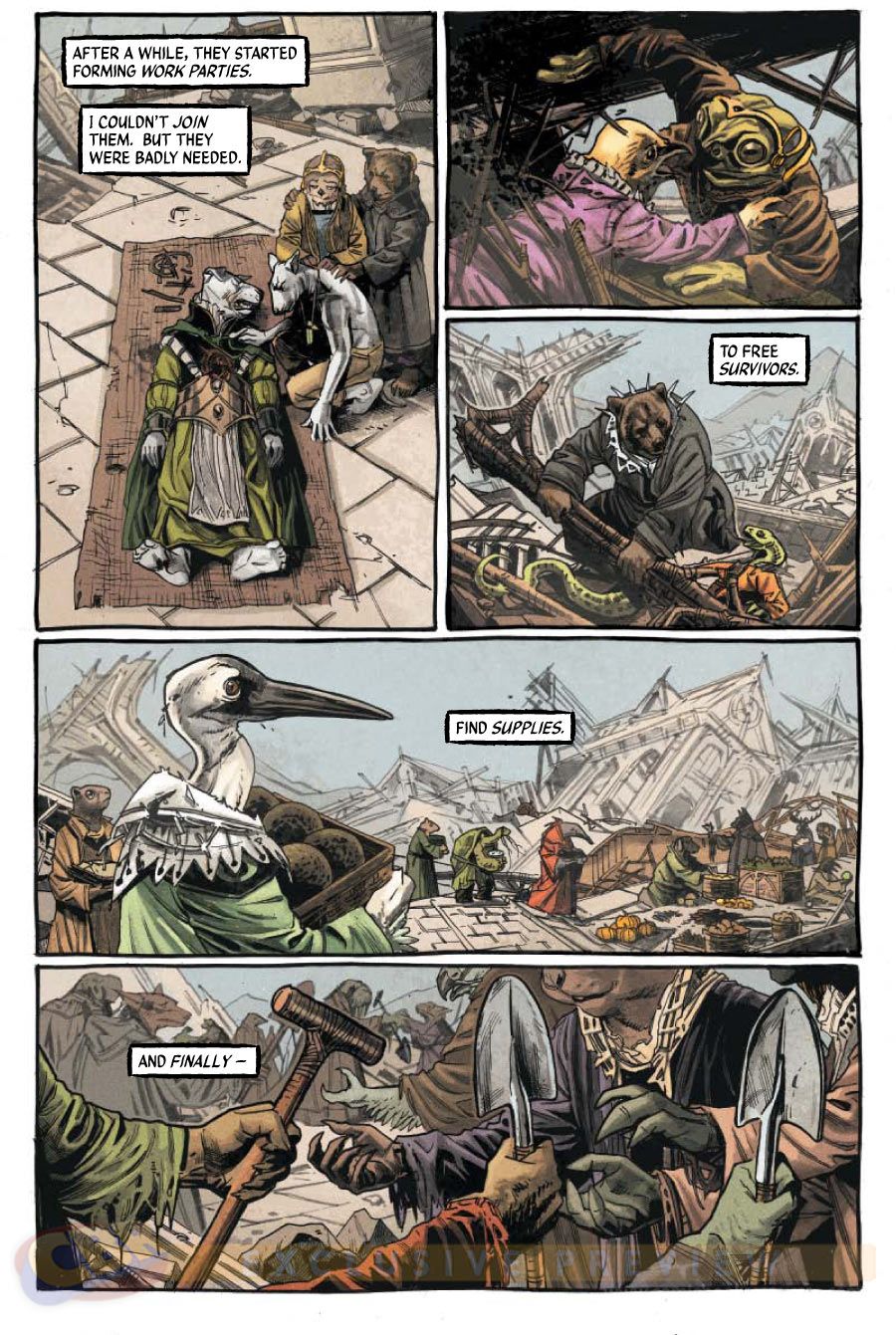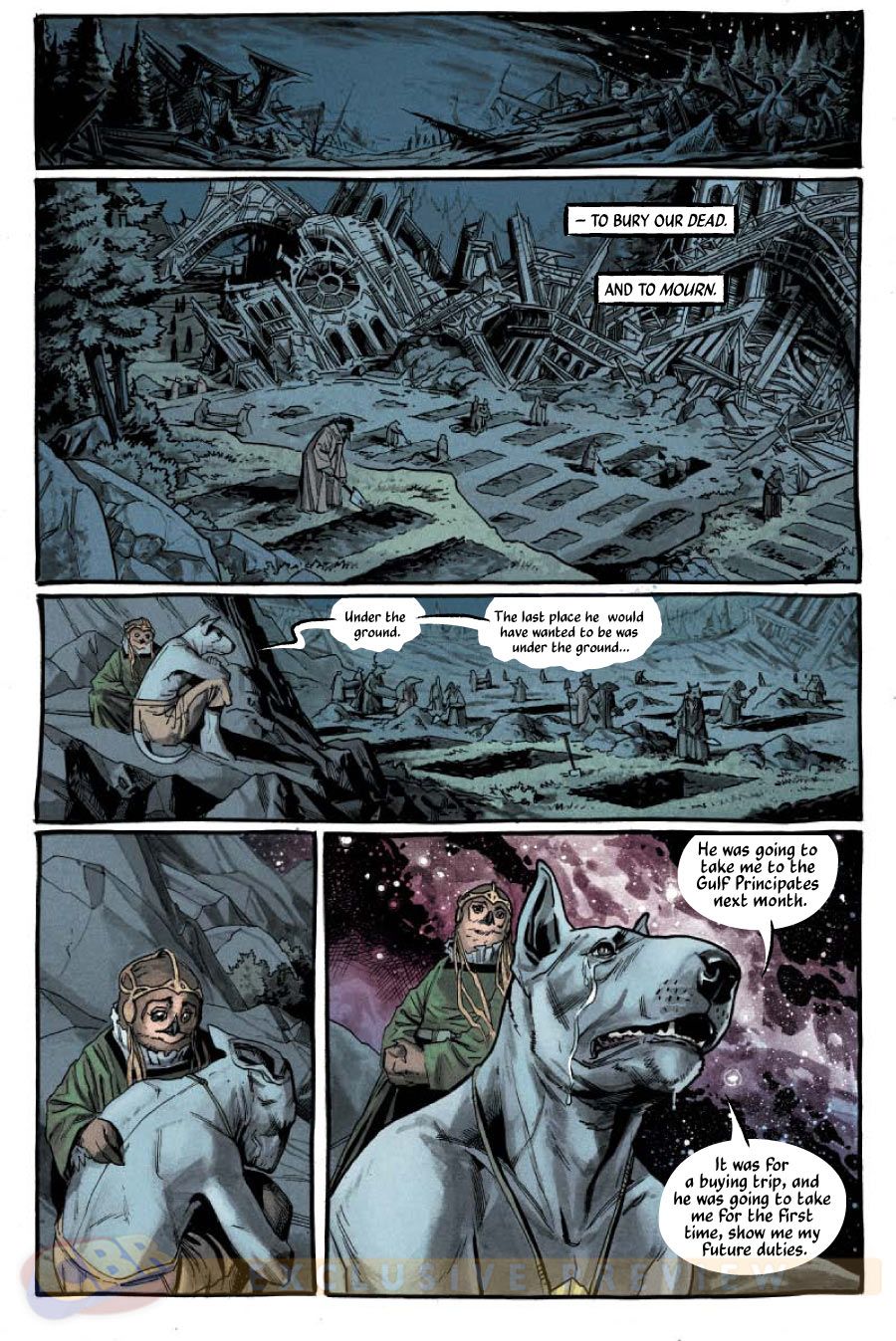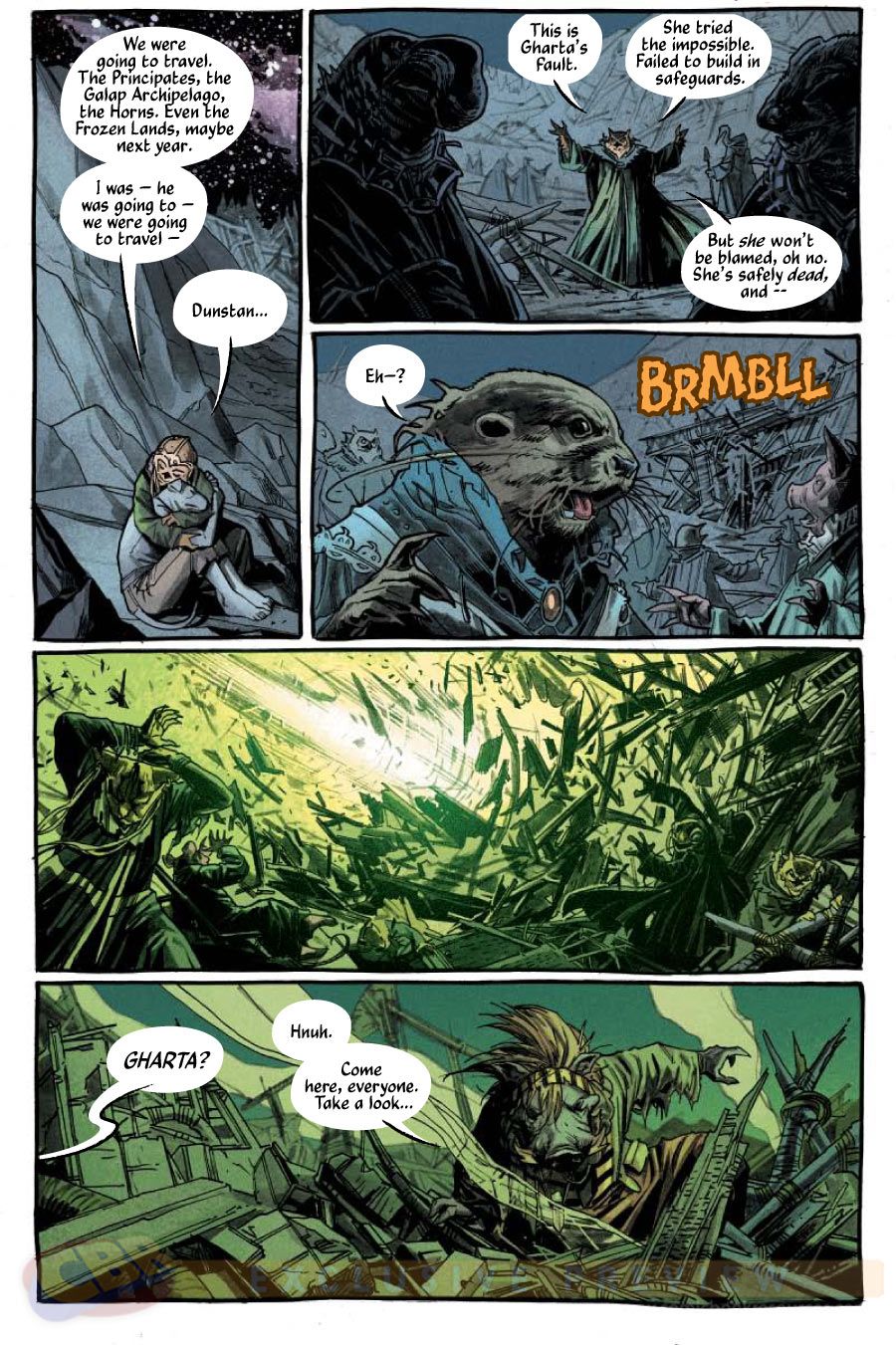From the talented mind of bestselling writer Kurt Busiek and the gifted artistic visions of Ben Dewey and Jordie Bellaire comes a sprawling high-fantasy, adventure where animal wizards, gods, con women and heroes clash in a fight that will test the bonds of humanity -- "Tooth and Claw." The first double-sized first issue (a whopping 44-pages with no ads in sight) joins the Image Comics lineup this November.
RELATED: Lemire & Nguyen Deliver "Descender" in 2015
CBR News has the exclusive first details on the project, straight from the creators' mouths, as Busiek and Dewey open up about "Tooth and Claw," digging into the mature content of the series, Dewey's immediate artistic connection to the project and how Busiek's decade-long vision is developing into a vast and beautiful world.
CBR News: Kurt, you'd said that you wanted to do this story for more than a decade while you've been building the world. Was there a moment where you realized that everything was ready? What gave you the final push to do this now?
Kurt Busiek: Not exactly a moment, more like a process. I've been in bad health for quite a while, and as I slowly recover, the first step was to get "Astro City" back on schedule and coming out. We've done that. The next step was to get something new going, to realize some of the ideas that have been kicking around in my brain demanding release. I actually talked to Eric Stephenson about this book a couple of years back, and he was very enthusiastic about it, so that started the process of finding the right artist, putting together a team, getting longest term storytelling plans nailed down, all that sort of good stuff.
I've said before how lucky I am to have run across Ben's [Dewey] work -- I saw his stuff at Emerald City Comicon, and really liked it -- and it was heavy on animal drawings to boot -- but it was a story he did for a "Planet of the Apes" annual that made me realize he'd be a good choice for the book. I knew he could draw great looking animal characters, and I knew he had a sensational visual imagination from reading "The Tragedy Series" but that was the first time I saw multiple pages of his storytelling, and I thought he had a great sense of place, of depth, of emotion, on top of all that other stuff.
Little did I know that Ben was even better suited than I could have imagined. Now that we've been working together for a while, I can't imagine anyone who'd be more ideal for it. Ben and I can be talking about something utterly unrelated to the book, and I'll realize, "Hey, we have to use that -- we're working that in to the story!" It's a great situation when you're working with an artist who's a real collaborator.
Anyway, Ben was finishing up other entanglements, and I was slowly getting healthier, so we started work on the book, and when we had enough of it done, Eric said, "How about November?" and we said, "Sure!"
So it was more a case of getting started and building momentum than one particular moment. I've been wanting to do the book for years, and once time and opportunity allowed for it -- here we are!
Much of your work -- apart from "Conan" and select others -- has been more all-ages appropriate, and "Tooth and Claw" is for mature readers. Can you talk a little about that?
Busiek: A lot of my work has been all-ages yeah. And that's partly because I've done a lot of stuff for Marvel and DC, both under the Comics Code and, when that went away, for books that they wanted to be all-ages anyway. And partly, it's because I have no problem writing for an all-ages audience -- I'm usually happy to do it.
But I like variety, too, and I don't ever want to do only one kind of thing. I read a lot of stuff that's not all-ages, and go to movies that aren't all-ages, and I have no problem with writing material that's for mature readers, as well. When Cary Nord and I did "Conan," and when Carlos Pacheco and I did "Arrowsmith," we kept bumping up against the mature-readers line, and several times had to have the colorist obscure things to avoid nudity or gore or whatever. So on this series, I went in knowing it was going to be a brutal world, where the violence was important, and where I didn't want to tease nudity the way we had to in "Conan" -- I wanted to do the story the way it felt right to me, and if that added up to mature readers, then so be it.
It's funny -- there are no restrictions on, say, James Bond novels, because there are no pictures. On TV, in movies, the lines are drawn different places. And in comics, we have a long tradition of being skittish about nudity and language and gore, so we've had this long divide between "all-ages" and "adults only," as if there's no middle ground. And then we have stuff in the middle ground, but it gets treated as "adults only," because different community standards freak out about different things, and retailers, unsurprisingly, don't want to be freaked out at.
"Tooth and Claw" is the kind of series that, on TV, would be on cable somewhere and start with a deep voice calmly saying that it's recommended for mature readers, due to violence, nudity and "strong language." In the movies, it'd be somewhere between a PG-13 and an R. But the reality is, I'm writing this for me and for readers like me, and I'm an adult with an adult sensibility. So I want to write it for adults, not "for-adults-but-with-coy-shadows-and-constrained-language" to make sure it's inoffensively adult.
That doesn't mean we've got a quota of "mature content" to hit -- if an issue plays out without any profanity or nudity, well, that's fine. But there are definitely going to be times we don't want to be coy -- in fact, the clash between polite civility and blunt reality is an important theme in the series -- so we don't want to be doing it with our hands tied behind our backs, either.
We'll go where the story takes us. "Tooth & Claw" will take us to some mature places.

Can you tell us more about the overall feel of the series?
Busiek: It's about fate and treachery and idealism and pragmatism and romance and adventure and saving the world, and about the world not being threatened by what you expected, and saving it not involving what you expected. It's about cynicism and disillusionment and tragedy and hope and passion. And it's about blood and death and magic and gods and humanity and animals and the difference between the two.
It's about exotic civilizations, about wicker cities that float in the sky, about great ocean-going empires, about slavery, about pack-roaches, crystal badlands that coruscate with power, undersea nomads eternally marching across the ocean floor, decaying golems of nuclear fire, boarding schools that have become governments, the limits of magic, the persistence of technology, and the bonds of loyalty.
It's...rococo. It's complex and overstuffed, influenced as much by the ornate fantasy of Jack Vance as by the comics of Jack Kirby. I find myself realizing I'm using things I learned from writing "Conan" and "Astro City," and things I learned from reading "Terry and the Pirates" and "Lord of the Rings." It's a high adventure series, but it's also a character series, and a big honking science fiction/fantasy epic. Swords, sorcery, mystery, myth, the highest of high stakes and the drama of day-to-day survival.
If you like a story as direct and passionate as my "Conan," you'll probably like this. If you like a world as complex as my "Arrowsmith," you'll probably like it. It's big and it's sprawling and it's personal and immediate, if the two together make sense.
And it's absolutely gorgeous.

The name "Tooth and Claw" -- is that reflective of the animal-people that inhabit this world, as well as the fight they're in for?
Busiek: To a degree, yes. And it's about more than that, too.
It's from Tennyson, who wrote of "Nature, red in tooth and claw" -- so on the surface, at least, it's about the beast-people that populate this world, who have teeth and claws. But they're far removed from their animal pasts, or at least many of them are. So whose teeth? Whose claws? Whose nature?
That's a question that'll come up, as we delve more into this world.
So the title's about the surface, and it's about what's going on under the surface, and the two aren't the same.
Who are some of the main characters we will meet?
Busiek: Our two leads are the Great Champion and Dunstan -- Dusty -- the orphaned son of a wizard of the Cities Above the Plain. I don't want to say much about the Great Champion, since we don't actually meet him until #2, and who he is and what he's like will be a revelation for the characters at least as much as for the readers. Actually, I think the readers will see some of what's coming with the Champion more readily than the characters, because they're watching from outside, and have a different perspective.
Dunstan, though, is a youngster from the canine tribes, a bull terrier who'd expected to follow in his father's path, as a senior wizard handling supplies and trade for his city. By the end of #1, though, Dusty's expectations of life are completely blown to shit, and he has no idea what's coming. But Dusty, overall, is young, enthusiastic, hopeful, and very sheltered and privileged -- he thinks he knows a lot about the world, but it turns out he only knows a corner of it, and it's a smaller corner than he would have imagined.
He's dreamed about traveling his whole life, and now he's going to -- but it's not going to be anything like his dreams.
Beyond those two, we'll be meeting a lot of new characters as the story travels around the world. But a couple of others:
Gharta the Seeker is the wizard who starts everything rolling. She's a warthog-wizard, impatient with the strictures and formality of most wizardly types -- she's just into figuring out the truth and how to fix things, not status or society or the latest fashionable elegance spells. She wants to confront the fact that magic is slowly fading away, by doing the impossible -- reaching into the past, to a time before magic, and bringing the great hero who unleashed magic into the world forward to the present, to do it again. And though things don't go the way she expects, she doesn't quit. Imagine Gandalf, if Gandalf was played by Linda Hunt. And was a warthog.
Goodfoot, who our wizardly adventurers meet in #3, is a coyote woman and a trader, who offers to help them out of their predicament, but may be more interested in lining her pockets instead. She's a trickster of sorts (hey, she's a coyote), but whether she's tricking you, or tricking others for you, it's not easy to tell.
There are plenty of other wizards -- including Sandorst the Exacting, who personifies pretty much everything Gharta has no use for -- and there's Seven-Scars, chieftain of the Bison Tribes, and Dusty's friends, and Lord Tallon, the big boss --
-- but this isn't a series that'll stay in one place and cultivate the same cast, issue after issue. Some of the characters we meet will be recurring characters, including Gharta and Goodfoot, but a lot of them will get left behind, to return only if and when our heroes get back to this area. They'll have lots of others to meet, from blind gods to elegant satraps to overemotional, destructive homunculi to the refugees of Candlewood to the shambling creatures that dare harvest the Crystal Wastes, and --
-- well, there's a lot of them.
So Dusty is the hero -- what qualities were important for you when developing the hero for this story?
Busiek: Dusty's one of our heroes, sure, but mainly, he's our viewpoint character. This is the world he grew up in, so he can play tour guide, at least to some degree. But much of the world is unfamiliar to him, so as he learns about it, we'll be learning along with him. Same for his relationship with the Great Champion -- he knows the legends of who this guy's supposed to be, but he doesn't have a clue as to who he really is.
So Dusty is going to help us step into the world -- but he's also got to discover the truth about it, and that journey of discovery is one the reader will take right along with him. He's someone who dreamed of adventure, but never thought it would really happen. So he's going to grow and change -- can he become a hero? Does he even really want to? -- and that'll be an interesting road to travel with him.
The Great Champion has his own set of discoveries to make, and growth and change, but for various reasons he's not the best person to let us see and understand along with him. So Dusty'll have to help out with that, too.

Since you'd been working on this series idea for over a decade, I have to think you have a strong point of view on the characters or world design.
Busiek: Yes and no.
There were various pieces of design that had developed in my head over the years -- the wicker cities, for instance, or the fact that Dunstan is a bull terrier. Those images were so strongly cemented in my mind that it'd have been very difficult for me to let go of them. And luckily, Ben saw cool visual ideas in the way I described them, and made them look great.
But for a lot of the other stuff, I knew that the world had to be visually striking, exotic, and fantastic, so we were going to need an artist who had the vision to deliver that, and to some degree I knew I'd need to get out of the way. Or at least to react to the artist's vision, and build on that, rather than trying to force everything through my own vision.
For instance, I didn't know Gharta would be a warthog until Ben and I started talking, and I saw his sketches for things, and he had a scientist in mind whose attitude he liked a lot for this character, and all of a sudden we were talking about a warthog wizardess, and she looks great. I throw around a lot of big ideas, and Ben comes up with ways to visualize them that involve a lot of texture, and that texture -- what kind of decorations the bison-men wear, for instance -- tells us more about this world and how it works, so we incorporate that and build on it for the next thing.
There are upcoming characters or settings where I've got a strong image in my head...but there's also a lot that is merely an idea or an emotion, or a cool-sounding name. And Ben'll make that come to life in a way that triggers a whole 'nother batch of ideas, and we'll bounce things back and forth.
It's more like discovery than like having it all nailed down for years. I know where the story's going, but the design of it all shapes the journey and builds from and to Ben's strengths as an artist.
How did the creative team come together?
Busiek: Ben was the one who got Jordie [Bellaire] involved, with his filthy alluring talent.
In Comicraft's case, I think JG would just say that I asked them. But he got to build on the art and the series ideas too, as we developed the look of the lettering.
Ben Dewey: I had been working on my webcomic (the tragedy series) and "I Was The Cat" for Oni press simultaneously and not having an easy time of it. I was trying to balance commercial work with two creator-owned projects while planning my wedding and I lamented to one of my studio mates that 'I wish I could just draw something like Kamandi as an ongoing series and get paid to do it, but I might as well wish that I could go on the roadand play guitar with Neko Case'
A week later Kurt called and said, "I've got this project I think you'd be a good fit for; have you ever heard of Kamandi? Well it is kind of like that but with magic." If Kurt didn't have a distinct voice I would have assumed it was a prank. Here is Kurt Busiek, writer of many of my favorite comics, asking me to do our version of Kamandi on magic steroids. I looked at my phone to see if I missed Neko's call.
Kurt writing anthropomorphic animal travel/adventure was the entire draw I needed. He had done such fun stuff in Conan and a bunch of other great titles; I knew it would be a blast. It also happens to be dovetailing well with the end of my web series and completion of some other long-running obligations. I'm ready to give this book everything I've got. It's the lucky chance of a lifetime!
Once Jordie said she was on board, I knew that this book was likely to be the best thing I'd ever get a chance to work on; I couldn't ask for a more ideal set of collaborators.
In a world this creative and vast, with so many unique elements and characters, what pieces have been the most challenging/enjoyable to work on artistically?
Busiek: I love writing Gharta, just because I know she's going to look so great in everything she does. She may come back sooner than expected, just because she's too much fun to leave out.
The toughest thing is making sure to give the story the room it deserves, even though my brain is screaming at me to get to the next idea, the next place, the next cool visual. There's so much stuff to tell, and I want to tell it all at once -- but I also want to tell it well, so I've got to pace it out instead of rushing through it.
I rewrote the first issue three times, and every change was about showing off more of the world, giving us better introductions to it, making sure Ben has room to get the ideas across visually. So a one-page scene becomes a three-page scene, with more detail, more nuance, more texture. A caption-heavy scene gets opened up, so we get to see more rather than just being told about it.
It's a treat to be able to bring this world to life, and the temptation is to race through it to show it all off. But if we do that, you don't get to see it the way it deserves. So finding the right balance is a challenge and a blast, at the same time.
It's why the first issue is double-sized (but for a single-issue price). To give us enough room to both get the story solidly started and to ease you into the world as we do..
Dewey: Kurt will ask for things that are huge in scale or require a ton of variety and all in a context that has no real-world one to one comparison. Not having a direct point of reference is hard for me but I do like improvising so I treat each creative pitfall as a chance to practice thinking about new approaches that force improvement and end up providing me with new tools. Ultimately. I just look at what I can currently do well and apply that tool set as I'm able, all while looking through the lens of storytelling which is what my favorite artists all do in unique ways. I consider it anathema to go through the motions and take it easy, so I'm glad to be learning things with every new page.
Floating wicker cities was not easy to pull off; I spent a lot of time looking at woven chairs and even built a cardboard model from a sketch I had made to help with color choices in a painting.
The enjoyment and the challenge are intertwined. If I finish working on a page and feel like I conveyed most of what Kurt and I wanted to see, I feel satisfied. My goal is to make a fun book for as many people as possible by imbuing the pages with joy, energy and clarity. I struggle towards a standard set by the ludicrously talented list of Kurt's past collaborators. Every day that I get to work on this book will be a victory and I just hope that we are able to draw in an audience that is as excited about reading it as I have been while working on it.

